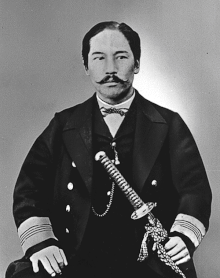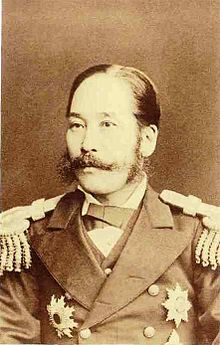Enomoto Takeaki

Enomoto Takeaki ( Japanese 榎 本 武揚 , or in respectful reading Enomoto Buyō ; * October 5, 1836 - October 26, 1908 ) was a Japanese admiral in the Navy of the Tokugawa Shogunate , who opposed the new government at the beginning of the Meiji Restoration of the emperor Meiji fought until the shogunate finally went under with the end of the Boshin War . However, he later served in the imperial government.
Studies in Europe
Enomoto was born to a family of Tokugawa followers . During the time of Japan's isolation ( Sakoku ), Japan had strictly limited contact abroad to a few countries such as Korea , China and the Netherlands . Enomoto began in the 1850s , Dutch to learn. After the forced opening of Japan by Commodore Matthew Perry in 1854, he studied Dutch naval warfare at the Nagasaki Naval Training Center of Bakufu and at the Tsukiji - Warship Training Center in Edo . At the age of 26 he was sent to the Netherlands, where he studied naval warfare from 1862 to 1867. He is said to have learned to speak fluent Dutch and English.
He returned to Japan in 1867 on board the Japanese battleship Kaiyō Maru , a modern steam-powered warship that the shogunate had bought in the Netherlands. On his return he was promoted to Kaigun Fukusōsai ( 海軍 副 総 裁 ), the second highest rank in the Navy of the Tokugawa Shogunate, at the age of 31 .
During his stay in Europe, Enomoto realized that the telegraph would be an important means of communication in the future. He began planning a telegraph system to connect Edo and Yokohama .
"The Last Loyalist"
When Meiji government troops defeated the Shogun's forces and captured Edo in 1868, Enomoto refused to surrender his warships. He fled with the shogunate's fleet and a handful of former French military advisers under Jules Brunet to Hakodate on the northern island of Hokkaidō . Its fleet of 8 steam-powered warships was the strongest naval association in Japan at the time.
She hoped to found a state in Hokkaido under the rule of the Tokugawa family, but the Meiji government refused to approve. On December 25th, the establishment of the Republic of Ezo was declared and Enomoto was elected President. He is therefore the first and only president of a state on Japanese soil to this day.
In the following year, the Japanese army and the Japanese navy started the invasion of Hokkaido and finally defeated the army and navy of the shogunate in the sea battle of Hakodate and the subsequent siege of the fort Goryōkaku .
On May 18, 1869, the Republic of Ezo capitulated and the rule of Emperor Meiji was recognized in Hokkaido .
The Meiji politician
Enomoto was captured and charged with high treason, but was pardoned by the new Meiji government in 1872. Their leaders felt that a man of Enomoto's talents could be of use to them. Under the protection of the Satsuma leader Kuroda Kiyotaka, Enomoto rose surprisingly quickly in the new ruling clique , faster and higher than any other member of the previous Tokugawa clan. He was one of the few former followers of the Tokugawa who also had political influence in Meiji Japan, a time when politics was dominated by the Tokugawa-hostile clans from Chōshū and Satsuma.
In 1874, Enomoto was made vice admiral and sent to Russia as a special envoy to negotiate the Treaty of Saint Petersburg , which was signed a year later. The conclusion of the contract was very positively received in Japan and further increased Enomoto's prestige in ruling circles. On the other hand, Enomoto's appointment was seen as a contribution to the national unity of Japan.
In 1880 Enomoto even rose to be the Japanese Minister of the Navy . He demonstrated his diplomatic skills again in 1885 when he assisted Itō Hirobumi in concluding the Treaty of Tientsin with China .
After that, Enomoto regularly held high posts in the Japanese government:
- 1885-1888 he was Japan's first communications minister after the cabinet system was introduced in 1885.
- 1888 and 1894-1897 he was Minister for Agriculture and Trade
- Minister of Education 1889–1890
- Foreign Minister 1891-1892.
In 1887 Enomoto received the rank of Shishaku (Vice Count) and membership in the Secret State Council , one of the most prestigious institutions of the Meiji period.
Even after that, he held several ministerial posts one after the other and was particularly active in promoting Japanese expansionism by promoting Japanese settler colonies in the Pacific , South and Central America .
In 1891, against the wishes of the cabinet of Matsukata Masayoshi, he founded a "Department for Emigration " in the Ministry of Foreign Affairs, whose task it was to promote emigration and to find possible new areas for Japanese settlements overseas. Two years later, Enomoto left the government and helped found a private colonial company to promote foreign trade and emigration.
He died in 1908 at the age of 72.
swell
- 函館 の 幕末 ・ 維新 . ISBN 4-12001-699-4
Remarks
- ↑ Japanese yūsokuyomi ( 有 職 読 み ). The Japanese name reading was replaced by a Sino-Japanese on reading .
Web links
| personal data | |
|---|---|
| SURNAME | Enomoto, Takeaki |
| ALTERNATIVE NAMES | 榎 本 武揚 (Japanese writing system); Enomoto Buyō (On reading) |
| BRIEF DESCRIPTION | Japanese admiral and politician |
| DATE OF BIRTH | October 5, 1836 |
| DATE OF DEATH | October 26, 1908 |



